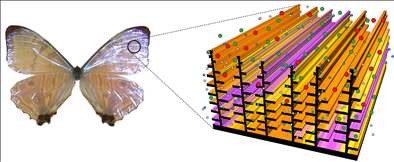Aug 13 2010
Scientists at GE Global Research, GE’s technology development arm, in collaboration with Air Force Research Laboratory, State University at Albany, and University of Exeter, have received a four-year, $6.3 million award from the Defense Advanced Research Projects Agency (DARPA) to develop new bio-inspired nanostructured sensors that would enable faster, more selective detection of dangerous warfare agents and explosives.
Three years ago, GE scientists discovered that nanostructures from wing scales of butterflies exhibited acute chemical sensing properties. Since then, GE scientists have been developing a dynamic, new sensing platform that replicates these unique properties. Recognizing the potential of GE’s sensing technologies for improving homeland protection, DARPA is supporting further research.
 This concept draws inspiration from the discovery by GE scientists that nanostructures on the wing scales of Morpho butterflies have acute chemical sensing capabilities.
This concept draws inspiration from the discovery by GE scientists that nanostructures on the wing scales of Morpho butterflies have acute chemical sensing capabilities.
Radislav Potyrailo, a principal scientist at GE Global Research and principal investigator, said, “GE’s bio-inspired sensing platform could dramatically increase sensitivity, speed and accuracy for detecting dangerous chemical threats. All of these factors are critical, not only from the standpoint of preventing exposure, but in monitoring an effective medical response if necessary to deal with such threats.”
Potyrailo noted that GE’s sensors can be made in very small sizes, with low production costs. This would allow large volumes of these sensors to be readily produced and deployed wherever needed. Unique sensing properties, combined with the size and production advantages offered by GE’s bio-inspired sensors, could enable an array of other important industrial and healthcare applications, including:
- Emissions monitoring at power plants
- Food and beverage safety monitoring
- Water purification testing for home, environmental and industrial applications
- Breath analysis for disease detection
- Wound healing assessment
Potyrailo said, “Now, more than ever, sensors are being used to collect data on gas concentrations and to deliver important information about air conditions in localized regions or over large distributed areas. This information can range from warning of impending chemical or health threats to more precisely measuring air quality at a power plant. The unique sensing properties of GE’s bio-inspired sensors provide an opportunity to improve the quality of this sensing data and the ability to collect this data at previously unavailable levels of detail”.
DARPA Program Manager Viktoria Greanya, Ph.D., said: “We have been greatly inspired by examples of naturally occurring optical structures whose properties arise from an intricate morphology. For example, the brilliant colors seen in butterfly wings, beetle carapaces, and peacock feathers are due in large part to their complex structure, not simply their color. DARPA’s goal in this program is to harness the best of nature’s own photonic structures and use advances in materials technology to create controllable photonic devices at visible and near-infrared wavelengths.”
For the DARPA project, GE has assembled a world-class team of collaborators who are recognized experts in their fields. They include: Dr. Helen Ghiradella, from State University at Albany, an expert on the biology of structural color; Dr. Peter Vukusic, from the University of Exeter, an expert on the physics of structural color; Dr. Rajesh Naik, from the Air Force Research Laboratory, with a strong background in bio-inspired functional materials and surface functionalization; and Dr. John Hartley, also from State University at Albany, specializing in advanced lithographic nanofabrication. These team members will complement GE’s strong multidisciplinary team of analytical chemists, material scientists, polymer chemists, optical engineers and nanofabrication engineers who are contributing to development of this new platform.
Source: http://www.genewscenter.com/